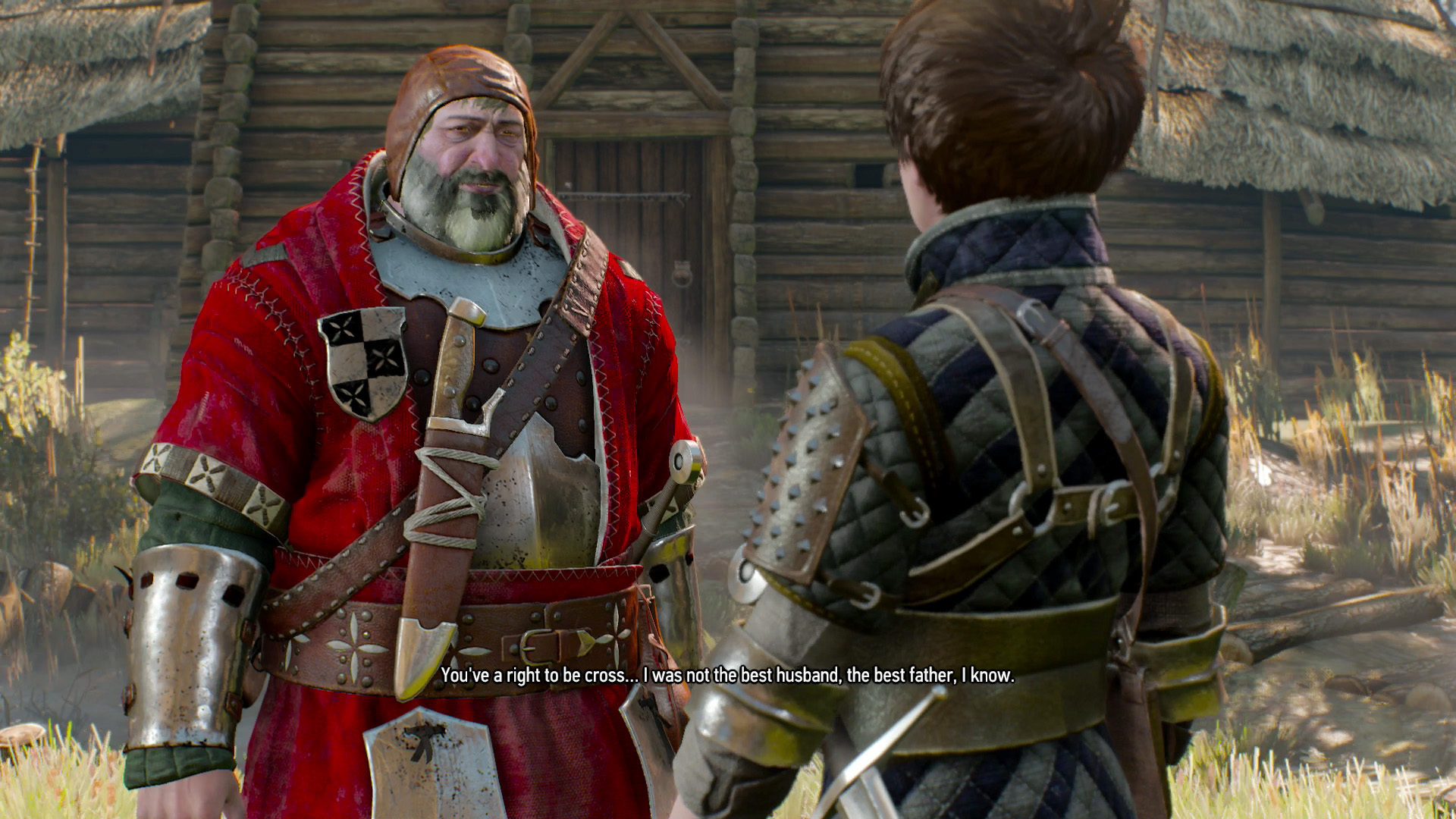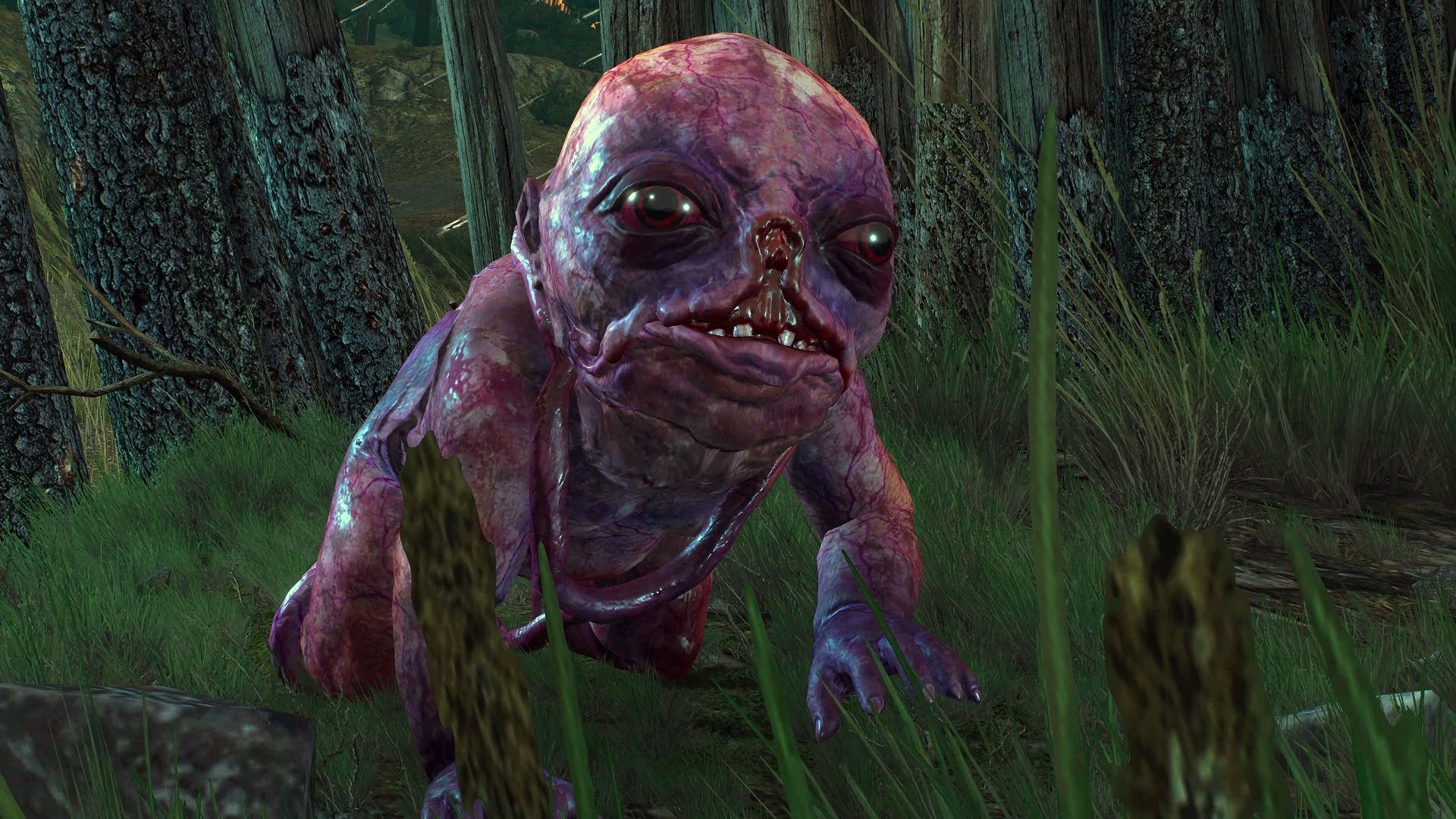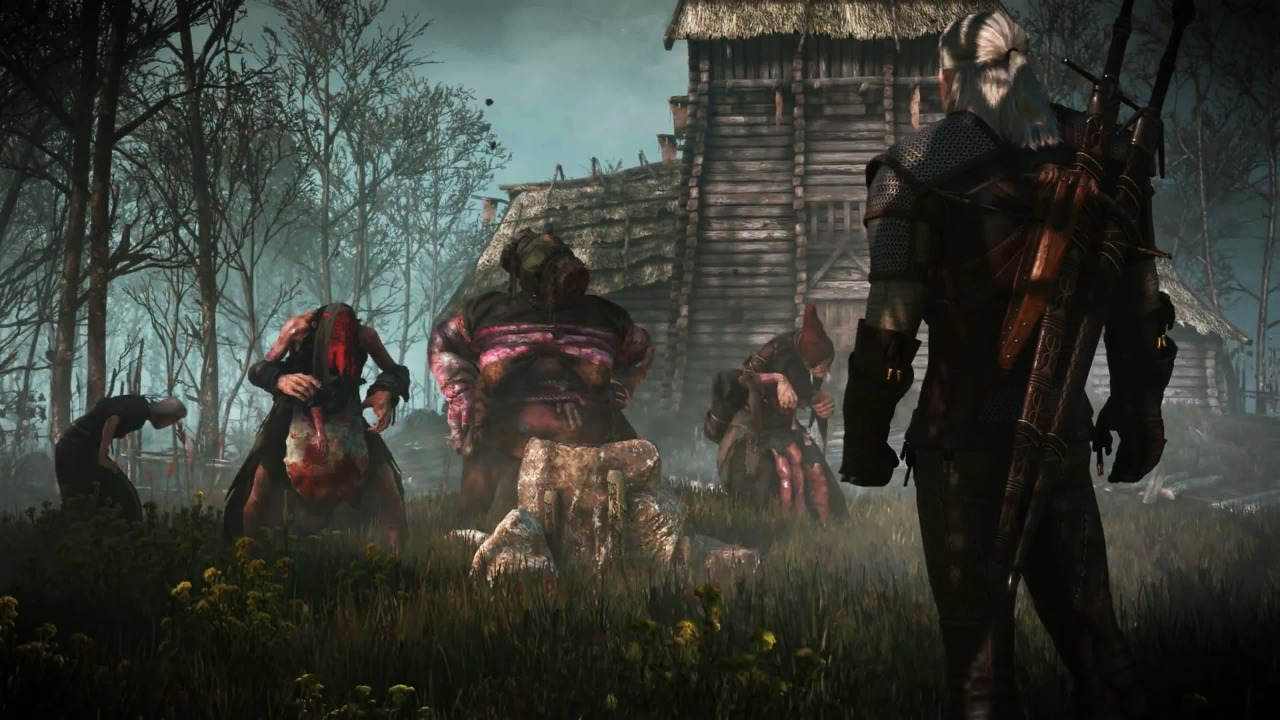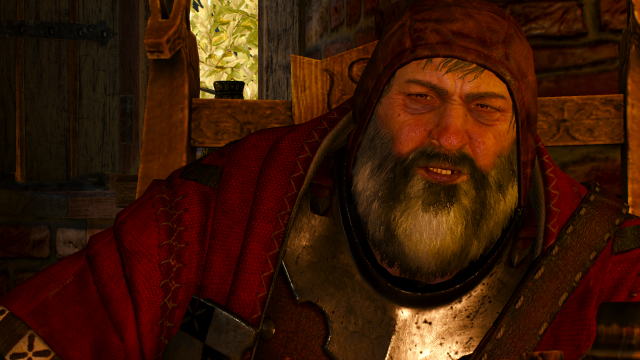If there’s a single story that encompasses the best of The Witcher 3‘s narrative ambitions, it’s the Bloody Baron. Messy, emotional, and full of morally compromised individuals, it’s a tale that can end in some truly harrowing ways. To learn more about how it came together, I spoke with the people who made it.
Warning: There are Witcher 3 spoilers to follow! Beware!
The only thing on Geralt’s mind in The Witcher 3 is finding Ciri. He’ll go to any lengths to track her down, even if that means dealing with a man called the Bloody Baron. Unsurprisingly for an RPG, the Bloody Baron has requests of his own, and tasks Geralt with tracking down his family, in exchange for some details about Ciri’s whereabouts. From there, players discover there’s much more going on. Murder, betrayal, alcoholism, unwanted children — the works.
“We started from a very basic draft that you could literally sum up with one sentence,” said lead quest designer Pawel Sasko. “Geralt meets a ‘Baron’ who wants the witcher to kill a monster and offers information about Ciri in return.”
There are two teams who work closely together to develop quests for The Witcher 3: writers and quest designers. First, a writer prepares an overview of what happens in the quest. Next, the document is handed over to a quest designer, who comes up with a more detailed description of what the player will actually do. From there, the two work in tandem to finalise everything.
Karolina Stachyra was the writer attached to to the Bloody Baron, which was part of a lengthy quest line called Family Matters.
“When I started working on this quest,” said Stachyra, “we only had a broad outline. We knew it was going to be about family issues and that it should be connected to Ciri. Then, Paweł Sasko and I started to think about how to enrich this story, how to make it more interesting and — somehow — haunting.”
For a while, the Bloody Baron was exactly that: a baron. Stachrya and Sasko grew bored of this scenario, however, and looked for ways to shake it up. They started by giving him a more detailed past, coming up with a lengthy history for the Baron and his wife. They explained how the two not only fell in and out of love, but grew to hate one other to the point of physical and emotional abuse.
“For me,” said Sasko, “the character of the Baron is a parallel to Geralt himself: two fathers who lost their loved ones, two adult men with blood on their hands, both involved in war, both with some personality issues, both capable of doing anything for their families.”

Someone with a different moral compass may have looked for another way to find Ciri, but not Geralt. The Baron offers Geralt his best (and fastest) shot.
The point of the quest was two-fold. Geralt needed a way to learn more about Ciri and CD Projekt RED wanted players to better understand what it’s like to be a regular person in this fantastical world. Geralt is a superhuman fighting things and casting magic, but most people are worrying about the next meal in a world “about war, lack of food, death, lost people, old rituals and monsters.”
Where the two overlap, though, is conveying life’s complexities. We all harbour regrets, mistakes, and decisions we’d probably take back.
The quest line plays out over hours and hours, which allowed Stachrya and Sasko to give players time to get to know the Baron. He wasn’t just a quest giver.
“At first I had a skeleton framework in mind,” said Stachrya, “which helped me to block out his main actions and words. Then I started to add some new aspects to the character. Paweł and I thought it would be interesting if a man who asks you to find his family turns out to be someone who actually ruined this family — but now realises his mistakes and wants to atone for his sins. That leaves the player in a very interesting and complicated situation — and gives him/her a wide range of different feelings and emotions. And that is what Wild Hunt is about, at core.”
Before you learn the Baron’s secrets, he talks about his wife and daughter with the deepest of affections. You feel for him. He comes across as a man torn between the obligations of ruling and family. It’s only when you put together the other details — he was an alcoholic, murdered a man his wife was seeing, beat his wife and caused a miscarriage — that everything becomes…complicated.
By complicated, of course, I mean really, really messed up.
“While creating a story,” said Sasko, “we always think about how to make it as close to real life as possible, how to make it believable. And let’s be honest, in real life, nobody is only good and no one is simply evil. And that’s a good thing, because a black and white world would be plain boring — as would a black and white game.”
Having to save or kill a botchling, an unwanted baby who was not given a proper burial, may not be “as close to real life as possible,” but it did the job.

And though the player’s immediate response may be to condemn the Baron for his actions, the game spends a huge amount of time showing his remorse. It’s up to you to decide if he’s worthy of forgiveness.
“Because everybody should have the right to choose,” said Sasko. “And besides, while as a player you control Geralt, in the end it’s still you making the decisions. And you should have the opportunity to decide who Geralt really is — meaning how he acts and responds in different situations, what he decides to do. It’s a role-playing game — to make it right and real, the player has to identify with the playable character — and how can this be done, if not by giving them the freedom to act?
“It’s also important to add that ‘choice’ is the heart of the Witcher games,” said Stachrya. “When the player has to make a decision regarding a character that he likes and dislikes at the same time, he will hesitate. He will think it through, analyse all the information he was given and then chose — but rarely will he be certain that it was a good decision.”
My version of the quest ended basically in tragedy. The wife, seeking independence, appeared cursed to work for the ladies of the wood, the hideous Crones. The daughter, thoroughly disgusted, rejects the Baron’s desire for a relationship. Having lost everything, the Baron hung himself outside of his home. But Geralt had the information he needed, so he went on his way.
Though shocked at the sight of the Baron — I spent all this time on this quest, only to have everything turn to shit?! — I wasn’t particularly upset, either. In my mind, the Baron wasn’t deserving of his family’s forgiveness.
“This is your interpretation of what happened,” said Sasko. “Another person may have described this situation in the following way: ‘I saved the Baron’s wife from death and the Baron couldn’t take it. He’s not going to harm anyone any more. This family was broken and destroyed long before this quest even happened and there was nothing that could be done to undo such destruction.’”
Based on what CD Projekt RED has seen, player reactions ran the gamut.
“For me this story is very personal,” said Stachrya. “I was born in a poor village in the Polish mountains and in my childhood I saw families broken by alcohol and violence. Being a child, I saw parents hitting kids and fighting with each other, while at the same time being in love and doing everything for their families. After the game was released, I watched the playthroughs, read forums and emails and observed what I expected to see: players reacted very differently, depending on their background. People who forgave the Baron were not the minority, which proved for me that giving this choice to the players was the right thing to do.

In the months since The Witcher 3 shipped, CD Projekt RED has received an enormous amount of feedback from people about this specific quest.
“One day there was a letter delivered to the office,” said Sasko. “It was sent by a father who had lost his daughter when she was a few months old. In his letter he wrote about his experience trying to save the Baron’s baby daughter which had turned into botchling, how desperately he wanted to save her. It was a moving story about him seeking redemption for the Baron, for this character who was carrying his beloved child in his hands. I was incredibly moved when I read it. If there was something we didn’t expect — it was these kinds of letters. Players were really touched by what we did and this is the biggest reward I could ever imagine.”
The whole quest plays with expectations. Geralt’s not your usual hero, but he’s often found saving people. It’s not unreasonable to expect the Baron’s light turning out this way, but instead, he’s merely a pawn in an awful game that’s been going on for years.
“It means not everything he [Geralt] touches turns into gold,” said Stachrya, “not every story he is involved in has to have a happy ending.”
patrick.klepek@kotaku.com or on Twitter at @patrickklepek.

Comments
7 responses to “The Personal Story Behind The Witcher 3’s Bloody Baron Quest”
just point out that Heart of stone is now available
In my play through, the baron had hung himself in the courtyard outside his keep, and the doll representing his wife was lying in the flowers under his feet. I later recalled him mentioning that this particular type of flower was her favourite, and she had taken pride in the garden. It was very moving and I felt genuine remorse for what I could have done differently.
Awesome, awesome game.
This was one of my favourite quest lines in the game, and one of the few in any game that really stuck with me after I finished playing. I felt so terrible about how things turned out that I only just managed to hold out against the urge to reload an earlier save and potentially get a better outcome. I think it really epitomises the Witcher world in general – painted in shades of grey instead of the common black and white of many other video games. Brilliant piece of storytelling.
Im still scarred by the choice i had to make under the roots of the great tree. I chose wrong. It really was the greater and lesser of two evils.
But i did feel for the Baron as an old washed out man trying for redemption with his family. However, I am pretty sure if i came across him in his past self, i would have brought my blade down on him without remorse.
Yeah. Every moment of that quest line was emotionally rough as guts. Even the “happy” ending was far from but.
GOTY. Bring on Hearts Of Stone!
I think the story plays with the idea that we all irrationally believe that we can judge what others “deserves” versus the perspective we’ve most often arbitrarily chosen. We never fight the urge to judge people despite knowing full well in the back of our minds that it never leads to progress. I never felt anger, I never felt a sociopathic desire to control what the characters should believe. I saw it, felt sad and understood the reality of violence and where it comes from. The amount of people (like Patrick) who feel empowered by ignoring how the violence developed and what family actually meant to each individual in favour of judgement I feel is what the game was trying to explore. It simply didn’t want to judge, it wanted to present, to explore and consider, it wanted to solve the problem, even when it couldn’t possibly be solved. There was something inspiring about the persistence that every character act as if they were real, and no stereotype pursued simply to fit a modern narrative. It felt real in a way that modern society doesn’t allow us anymore, we always need to blame the bad guy before solving the problem. It was still easy to blame him but it never let you do it without showing you the futility of it, that the problem comes before your gratification.
Great comment.
Just in case anyone wasn’t aware, the Witcher 3 DLC is out.